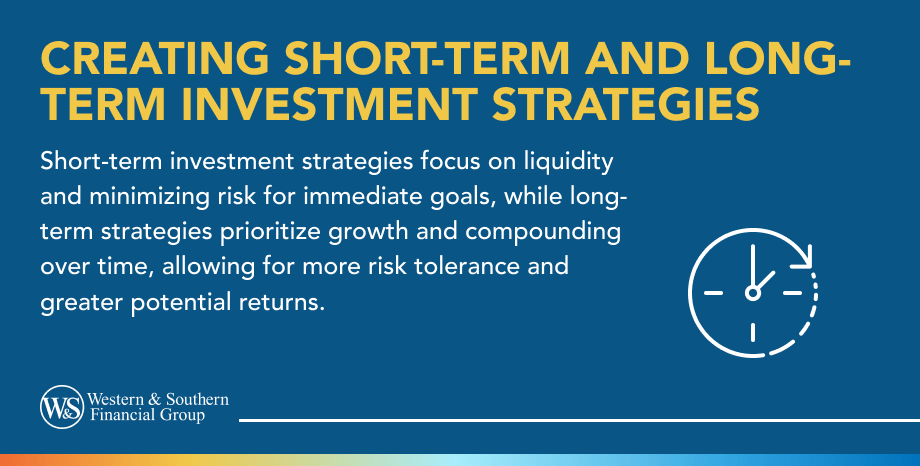Table of Contents
Table of Contents


Key Takeaways
- Consider your investment timeline and risk tolerance when forming investment strategies. Long-term investors can take more risk than short-term investors.
- Assess your risk capacity - how much can you afford to lose in the short-term. This affects how much risk you can take.
- Understand the relationship between risk and return. Higher returns generally require taking more risk.
- Factor in taxes when choosing investments and accounts. Some accounts and investments are more tax efficient.
- You can create your own strategy if you feel knowledgeable, or get help from a financial advisor to customize it.
Before choosing your investments, it's important to identify the fundamental considerations that go into your investment strategy, such as your investment timeline and your tolerance for risk. Once you've done so, you can form long-term and short-term investment strategies that compliment each other and get you closer to your goals.
What Are Long-Term Investment Strategies?
Long-term investment strategies will include the tactics and investment types used to accomplish an investment goal that is a significant number of years away. Common long-term investment goals include retirement and college savings.
What Are Short-Term Investment Strategies?
Short-term investment strategies will include tactics and investment types targeted toward an investment goal with a timeline of three years or less. Typical short-term investment goals include saving for a vacation, a wedding or the purchase of a vehicle.
Considerations for Forming Investment Strategies
There are a number of general considerations to keep in mind when forming investment strategies. These include timeline to invest, risk tolerance, risk capacity, desired rate of return, taxes and whether you want to do it yourself or work with a financial professional.
Timeline to Invest
Your timeline to invest is the amount of time between now and the day you begin making withdrawals from your investment account. If you have a significant number of years to go before reaching retirement, you can consider yourself a long-term investor.
If you have three years or less to invest, you can consider yourself a short-term investor. A four- to seven-year timeline is considered intermediate. A long-term investor may enjoy less risk due to the fact they have more time for the portfolio to make up for potential losses. Meanwhile, short-term investors may want to avoid volatile investments, such as some stocks or stock mutual funds.
Risk Tolerance
Risk tolerance is the term for how much risk you are willing to deal with. Although long-term investors can afford to take more market risk, they might want to invest in a way that suits their personal tolerance for risk. For example, a portfolio of stocks can be suitable for a long-term investor with high risk tolerance. However, including certain bonds in the investment mix may be more suitable for a long-term investor with low to moderate risk tolerance.
Risk Capacity
The degree to which you can financially afford to see short-term declines in the value of your investment accounts determines your rick capacity. For example, investors who are fortunate enough to have surpassed their savings goals or those who do not foresee ever needing to make withdrawals from their accounts can have high risk capacity. Those who risk missing their savings goals due to a severe market downturn may have lower risk capacity.
Desired Rate of Return
There is a direct correlation between risk and reward with investing. Generally, the higher the return you are seeking, the more market risk you may need to accept to obtain that return. Some individual stocks are relatively high in market risk and have historically averaged higher returns than bonds, which are relatively low in market risk.1
Taxes
You might want to consider your income tax rate — or your desire to avoid or reduce taxes — when choosing your investment strategy and investment types. For example, if you want to minimize taxes and you are investing for retirement, you may choose a tax-deferred investment account, such as an IRA. If you are a long-term investor and you have a taxable brokerage account, you may want to choose tax-efficient investments, such as index funds, ETFs or municipal bond funds. Keep in mind that each account type or investment product has its own unique features or requirements that you should fully understand before investing.
Do It Yourself? Or Hire a Financial Professional?
Each person's investment strategy will be unique to their individual goals and tolerance for risk. If you feel comfortable and knowledgeable about investments, you may be able to choose and implement your own investment strategies. But it can make sense to consider hiring an investment advisor or financial professional to recommend investment types and help guide you in choosing an investment strategy.
Preparing to Move Forward With an Investment Strategy
Forming the right investment strategy for you will depend on several factors, such as your timeline to invest, tolerance for risk and desired rate of return. Once your investment objectives and risk tolerance are identified, the specifics of your investment strategy, such as the types of investments, can be determined.
Since investment objectives and strategies are unique to the individual, it can make sense to seek the help of a financial professional, who can provide customized guidance.
Maximize your potential with investing strategies that work short or long term. Invest In My Future
Sources
- How do bond returns compare with stock returns? https://money.cnn.com/retirement/guide/investing_bonds.moneymag/index3.htm.
























